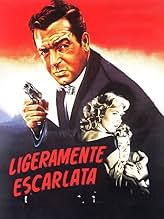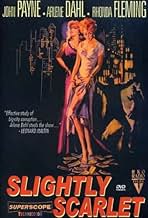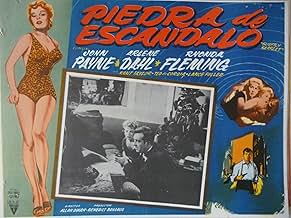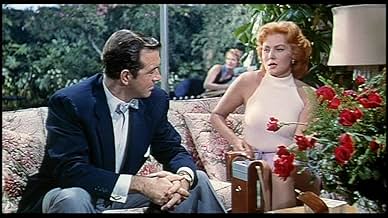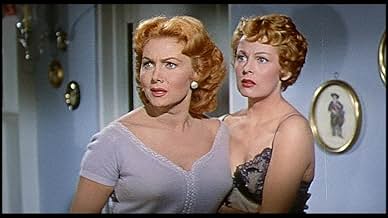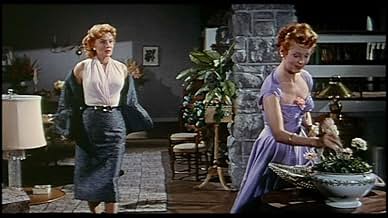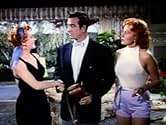IMDb RATING
6.5/10
1.4K
YOUR RATING
An urban wheeler-dealer gets involved in organized crime, corrupt city politics and graft while falling in love with the fiancée of the newly elected mayor.An urban wheeler-dealer gets involved in organized crime, corrupt city politics and graft while falling in love with the fiancée of the newly elected mayor.An urban wheeler-dealer gets involved in organized crime, corrupt city politics and graft while falling in love with the fiancée of the newly elected mayor.
Fred Aldrich
- Policeman
- (uncredited)
Murray Alper
- Hood
- (uncredited)
Albert Cavens
- Man at Campaign Headquarters
- (uncredited)
Ellen Corby
- Martha
- (uncredited)
Paul Cristo
- Man at Campaign Headquarters
- (uncredited)
Sam Flint
- Man at Campaign Headquarters
- (uncredited)
Curt Furberg
- Man at Campaign Headquarters
- (uncredited)
Rudy Germane
- Hood
- (uncredited)
Frank Gerstle
- Dave Dietz
- (uncredited)
Kenneth Gibson
- Man at Campaign Headquarters
- (uncredited)
Roy Gordon
- General Norman B. Marlowe
- (uncredited)
- Director
- Writers
- All cast & crew
- Production, box office & more at IMDbPro
Featured reviews
"You're not good; you're not bad. You're a chiseler, out for anything you can get."
So, says Solly Kaspar, crime boss of Bay City, of Ben Grace, the anti-hero of this story, adapted from James M. Cain's Love's Lovely Counterfeit. What holds our interest in this story is we're never quite sure what to make of Grace.
There's an upcoming election and crime boss Kasper does not want the reform candidate to win, so Kasper strongarms the newspaper publisher backing him, and in the process kills him.
Grace exposes Kasper, forcing Solly to flee to Mexico, and insuring the election of Frank Jansen, the reform candidate. He uses his influence with Jansen to get an honest police lieutenant friend of his appointed Chief of Police.
Good guy, right?
Then later in this movie he's seen giving orders to Solly's men, going over Solly's books, and positioning himself as Solly's successor. He calls his friend,the chief of police, and demands that his girlfriend's sister who was recently arrested be released without being charged, and so we begin to believe we've misjudged ol' Ben. He's just a hood, a little brighter than most, a little smoother than most, but in the end, no different from Solly Kasper.
Bad guy, right?
Well, we're not sure, because Grace isn't sure. Reform mayoral candidate, soon to be mayor, Frank Jansen has an assistant, June Lyons. On a 1 to 10 scale, Ms. Lyons, with her flaming red hair, and blazing headlights (think Good Girl art) is an 11. Rhonda Fleming never looked better, and Arlene Dahl as her sister, Dorothy Lyons, was equally stunning. But, back to Grace. He is falling for June, and June is a thoroughly decent girl, whose better nature seems to affect him.
In the end, however, Grace's schemes come to naught. Jansen who really is a reform candidate orders Dorothy be tried for her crimes. Solly Kasper returns wanting to take over as rackets boss, and Ben Grace is forced to run. Here's where we see his true character, when he scrounges as much of Solly's money as he can and invites his girlfriend to go on the run with him (she declines).
Solly Kasper was right all along. He really is just a chiseler, out for whatever he can get. Major disappointment, as in the end, Ben Grace disappoints not just his girlfriend, but the audience as well.
This is a beautifully photographed movie in full technicolor. The sets are a wonderful amalgam of art deco - rococo excess. Others here have pointed out how garish everything looked. I didn't find it so. I thought it was beautiful. Certainly, the eye candy was stunning. There aren't any two actresses today who could team as good girl - bad girl siblings the way Fleming and Dahl did. Maybe Julianne Moore and Debra Messing, but they wouldn't look as good. The movie's high marks for visual style are undermined by its low marks for aimless, meandering story. 6 out of 10.
So, says Solly Kaspar, crime boss of Bay City, of Ben Grace, the anti-hero of this story, adapted from James M. Cain's Love's Lovely Counterfeit. What holds our interest in this story is we're never quite sure what to make of Grace.
There's an upcoming election and crime boss Kasper does not want the reform candidate to win, so Kasper strongarms the newspaper publisher backing him, and in the process kills him.
Grace exposes Kasper, forcing Solly to flee to Mexico, and insuring the election of Frank Jansen, the reform candidate. He uses his influence with Jansen to get an honest police lieutenant friend of his appointed Chief of Police.
Good guy, right?
Then later in this movie he's seen giving orders to Solly's men, going over Solly's books, and positioning himself as Solly's successor. He calls his friend,the chief of police, and demands that his girlfriend's sister who was recently arrested be released without being charged, and so we begin to believe we've misjudged ol' Ben. He's just a hood, a little brighter than most, a little smoother than most, but in the end, no different from Solly Kasper.
Bad guy, right?
Well, we're not sure, because Grace isn't sure. Reform mayoral candidate, soon to be mayor, Frank Jansen has an assistant, June Lyons. On a 1 to 10 scale, Ms. Lyons, with her flaming red hair, and blazing headlights (think Good Girl art) is an 11. Rhonda Fleming never looked better, and Arlene Dahl as her sister, Dorothy Lyons, was equally stunning. But, back to Grace. He is falling for June, and June is a thoroughly decent girl, whose better nature seems to affect him.
In the end, however, Grace's schemes come to naught. Jansen who really is a reform candidate orders Dorothy be tried for her crimes. Solly Kasper returns wanting to take over as rackets boss, and Ben Grace is forced to run. Here's where we see his true character, when he scrounges as much of Solly's money as he can and invites his girlfriend to go on the run with him (she declines).
Solly Kasper was right all along. He really is just a chiseler, out for whatever he can get. Major disappointment, as in the end, Ben Grace disappoints not just his girlfriend, but the audience as well.
This is a beautifully photographed movie in full technicolor. The sets are a wonderful amalgam of art deco - rococo excess. Others here have pointed out how garish everything looked. I didn't find it so. I thought it was beautiful. Certainly, the eye candy was stunning. There aren't any two actresses today who could team as good girl - bad girl siblings the way Fleming and Dahl did. Maybe Julianne Moore and Debra Messing, but they wouldn't look as good. The movie's high marks for visual style are undermined by its low marks for aimless, meandering story. 6 out of 10.
Any story by James M. Cain should automatically command one's attention. Though probably not as famous as his other stories, this one manages to hold the viewer's interest. A curious thing to me is that, once again, the male lead is playing a far from sympathetic character (Ben). John Payne does a good good job, though sometimes it is not easy to figure out what Ben is up to or why. The success of the film rests upon the performance of the two female leads, Rhonda Fleiming and Arlene Dahl, especially the latter, whose acting was way beyond what I expected and almost carries the film, the ending of which might be a bit surprising. A tad slow in spots, 'Slightly Scarlet' nevertheless is a pretty entertaining film.
I am a trained psychotherapist, so when I watched "Slightly Scarlet", I saw things some others might not see. I mention this because one of the main characters, Dorothy (Arlene Dahl), is a psychological mess. She's a compulsive thief and a girl who craves excitement...all in the worst way. Today, she'd almost certainly be diagnosed with a Borderline Personality...meaning she possesses many qualities of a variety of personality disorders. Antisocial behavior, addictive behaviors and highly volatile mood swings...these are typical of such an individual...and Dorothy is very clearly dealing with these issues.
The film begins with Dorothy being released, yet again, from prison for shoplifting. Her enabling sister, June (Rhonda Fleming), tries her best to help Dorothy but it's clear Dorothy doesn't want saving....she's hell-bent on self destruction, good times and chasing men. Sadly, June is an idiot when it comes to Dorothy and she makes excuses for her wayward sister...and in many ways she enables and encourages Dorothy's actions. How far will all this go? And, how long will June put up with her sister's horrible behaviors? And, how long does Ben (John Payne) fit into all this?
This is a very exciting film that you'll either love or hate. Dorothy's behaviors and June's reactions to them can feel very frustrating....and I could see viewers hating BOTH sisters. But, if you can look past this, the film is fun to watch and worth your time. In some ways, it's like film noir...but the color cinematography make it hard to call it noir. Still, I enjoyed it despite its shortcomings.
The film begins with Dorothy being released, yet again, from prison for shoplifting. Her enabling sister, June (Rhonda Fleming), tries her best to help Dorothy but it's clear Dorothy doesn't want saving....she's hell-bent on self destruction, good times and chasing men. Sadly, June is an idiot when it comes to Dorothy and she makes excuses for her wayward sister...and in many ways she enables and encourages Dorothy's actions. How far will all this go? And, how long will June put up with her sister's horrible behaviors? And, how long does Ben (John Payne) fit into all this?
This is a very exciting film that you'll either love or hate. Dorothy's behaviors and June's reactions to them can feel very frustrating....and I could see viewers hating BOTH sisters. But, if you can look past this, the film is fun to watch and worth your time. In some ways, it's like film noir...but the color cinematography make it hard to call it noir. Still, I enjoyed it despite its shortcomings.
Anyone remotely interested in cinematography and art direction should see this. John Alton, chiefly famous for his work in black and white, here switches to livid colour and achieves some of the most daring and moody effects ever known in colour films. This was a decade before 'flashing' the film became popular (a technique developed by Freddie Young, who told me all about it at the time he began the trend, with Lumet's 'Deadly Affair'). Everything here is so vivid, and the games played with colour in choice of sofas, walls, carpets, not to mention hair, are so intense, that the film is really chiefly of interest for all of that. Alton had to work only with variations in lighting, not with film processing possibilities. What he did is incredibly audacious, worth watching over and over just to study it. He has whole figures in shadow, and faces often are eclipsed by darkness in a bright room. It is really an incredibly dazzling display of virtuosity and genius. The two lead gals have matching hair, which plays well on the sets. Rhonda Fleming was a notorious strawberry blonde, and although I seem to recall that Arlene Dahl was really a normal blonde and presumably had her hair died to match Fleming's for this film, here they are very like the sisters they play indeed, with matching peachy hair and bright blue eyes. It is all a symphony of light and dark and colour combinations, like a modernist painting. The story is tepid, diluted from a James Cain novel about city corruption and crime. Arlene Dahl is not very convincing as a kleptomaniac siren who is supposed to be deeply psychologically disturbed (that part only comes out at the end, though we know about the thefts from the beginning, as the film begins with her coming out of prison). Rhonda Fleming swings her hefty bust around with confidence, and glares with her blue eyes at people as she challenges them, which with her fiery nature she does a lot. Into this mix comes a very seedy character played by John Payne, who by this time was really getting a little too old for such roles, nice fellow though he was. However, a sufficiently noirish tale ensues which is worth watching, though it is not a proper film noir, but merely has certain elements of that left, as the mid-1950s were asserting themselves, and people were getting more interested in Debbie Reynolds and Doris Day, and the War was a fading memory, and even the Korean War was passé by this time. Yes, things were changing, people were getting cheerier and more bourgeois by the minute, and gloom was no longer so popular, or must be relegated to horror films instead. Time to lighten up! So this is an interesting historical curiosity, a lingering shadow cast over the smiling face of a complacent Middle America which was just settling down to a nice long afternoon nap which would last until the sixties.
The 1956 film "Slightly Scarlet" at first glance looking back from our sophisticated perspective today seems to be a bit of a tongue-in cheek joke.
Directed by Allan Dwan from a Robert Blees screenplay adapted from James M. Cain's novel "Love's Lovely Counterfeit", the 99-minute film is a great combination of color and art direction in a film noir.
Not a highly regarded film noir, in Technicolor and Superscope its palette utilizes a wide range of color to support the individual themes and characterizations.
Our main characters have color scheme that establish them and develop with the story.
Arlene Dahl as Dorothy wears black as she is released from prison and even sports a black bathing suit later in the film.
Rhonda Flemming as June initially appears in Spring-like colors of off-white and yellow, with colors matching her mood as the film progresses. She wears white and blues when she meets Ben Grace for the first time, then black and off-white when they kiss and she begins to fall in love with him. When Dorothy is arrested Rhonda wears a grey sweater and skirt but by the end of the film June wears the same black color as Dorothy emphasizing her relationship to her bad sister.
Although the pivotal action of the film rests on Ben Grace, it is through June that we understand the important elements of the story, and the value of good and bad in this noir world as well as our own.
A study in duality, it falls short by not delivering what it promises but only shifts the pivotal actions onto the male character in the film.
In more than one scene characters tell Ben Grace that he is taking advantage of the situations around him to unfair terms.
Police man Dietz (Frank Gerstle), who Grace gets put into a high-ranking position accuses Ben of playing both ends toward the middle.
A great line from Sole Caspar to Ben Grace sums up his character completely: "Genius you're just a chiseler out for a soft spot. You're not crooked and you're not straight. You take what you can get where you can get it but you don't want any trouble. You'll die at age 66 with three grand in the bank but you'll never be an operator." Looking back its moments of plot change create humor because of the style of acting and the overall writing in the script.
But there is still ample example of real noir elements despite the color of the film.
The title suggests the slightly scarlet is a pun on the pure heart of the lead female as measured against the overall 'sick' nature of her sister, the one who steals.
The quality of the motivation to steal of the second female lead as compared against the organized mob activities of the lead crook is an interesting one. There is the opportunity foe the woman to become the girlfriend of the mob boss, and she seems perfectly matched for the role.
Directed by Allan Dwan from a Robert Blees screenplay adapted from James M. Cain's novel "Love's Lovely Counterfeit", the 99-minute film is a great combination of color and art direction in a film noir.
Not a highly regarded film noir, in Technicolor and Superscope its palette utilizes a wide range of color to support the individual themes and characterizations.
Our main characters have color scheme that establish them and develop with the story.
Arlene Dahl as Dorothy wears black as she is released from prison and even sports a black bathing suit later in the film.
Rhonda Flemming as June initially appears in Spring-like colors of off-white and yellow, with colors matching her mood as the film progresses. She wears white and blues when she meets Ben Grace for the first time, then black and off-white when they kiss and she begins to fall in love with him. When Dorothy is arrested Rhonda wears a grey sweater and skirt but by the end of the film June wears the same black color as Dorothy emphasizing her relationship to her bad sister.
Although the pivotal action of the film rests on Ben Grace, it is through June that we understand the important elements of the story, and the value of good and bad in this noir world as well as our own.
A study in duality, it falls short by not delivering what it promises but only shifts the pivotal actions onto the male character in the film.
In more than one scene characters tell Ben Grace that he is taking advantage of the situations around him to unfair terms.
Police man Dietz (Frank Gerstle), who Grace gets put into a high-ranking position accuses Ben of playing both ends toward the middle.
A great line from Sole Caspar to Ben Grace sums up his character completely: "Genius you're just a chiseler out for a soft spot. You're not crooked and you're not straight. You take what you can get where you can get it but you don't want any trouble. You'll die at age 66 with three grand in the bank but you'll never be an operator." Looking back its moments of plot change create humor because of the style of acting and the overall writing in the script.
But there is still ample example of real noir elements despite the color of the film.
The title suggests the slightly scarlet is a pun on the pure heart of the lead female as measured against the overall 'sick' nature of her sister, the one who steals.
The quality of the motivation to steal of the second female lead as compared against the organized mob activities of the lead crook is an interesting one. There is the opportunity foe the woman to become the girlfriend of the mob boss, and she seems perfectly matched for the role.
Did you know
- TriviaArlene Dahl offered to play cards with Rhonda Fleming to determine who would be the first on the poster. Dahl won the game, and in return demanded that Fleming be the first in the credits of the film. Fleming was very touched by this gesture and the two actresses became good friends.
- GoofsVery early in the film, just after Dorothy Lyons has been released from prison, Ben Grace is in police Lt. Dietz's office discussing her. The lieutenant is perusing Miss Lyons' criminal file which the viewer can briefly view. At the top of the document a spelling error displays her name as "Dorthy Lyons".
- Quotes
Solly Caspar: Let's see if we can beat him down.
[after throwing a body out of an upper story window]
- ConnectionsFeatured in Saving Cain: Robert Blees on 'Slightly Scarlet' (2009)
- SoundtracksFor He's A Jolly Good Fellow
(uncredited)
Traditional
Heard at the announcement of the election results
- How long is Slightly Scarlet?Powered by Alexa
Details
- Release date
- Country of origin
- Official sites
- Language
- Also known as
- Straße des Verbrechens
- Filming locations
- Production companies
- See more company credits at IMDbPro
- Runtime
- 1h 39m(99 min)
- Aspect ratio
- 2.00 : 1
Contribute to this page
Suggest an edit or add missing content



